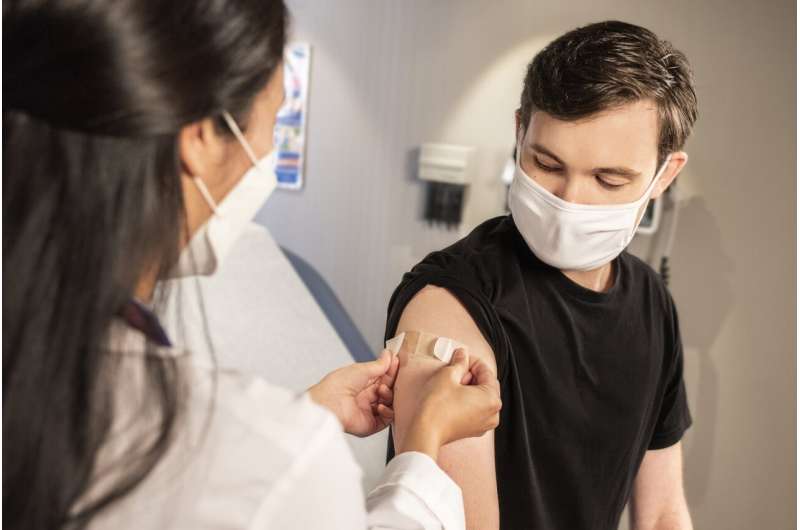

A multidisciplinary team of researchers is the first to show combining yeast-expression technology and a novel adjuvant formulation to produce a COVID-19 vaccine candidate is effective against SARS-COV-2 and promises to be easy to produce at large scale and cost-effective, important aspects for vaccinating people worldwide, especially in low- to middle-income countries. Results from the study, which applied lessons learned from the hepatitis b vaccine platform technology, are published online today in Science Immunology.
Researchers from the Yerkes National Primate Research Center (NPRC) at Emory University, Infectious Disease Research Institute (IDRI), 3M and Texas Children’s Hospital’s Center for Vaccine Development at Baylor College of Medicine paired Baylor’s SARS-CoV-2 Receptor Binding Domain (RBD) recombinant protein formulation vaccine candidate with IDRI’s aluminum-based formulation of 3M’s Toll-like receptor 7 and 8 agonist 3M-052 (3M-052/Alum) to enhance immune response against SARS-CoV-2 and, thus, increase vaccine effectiveness against COVID-19.
“Working with rhesus macaques, we found 3M-052/Alum formulation produced a significant and superior overall immune response than alum alone, a licensed adjuvant,” says corresponding author Sudhir Kasturi, Ph.D. “The superior immune response from our RBD+ 3M-052/Alum vaccine resulted in a significant reduction of SARS-CoV-2 in upper and lower respiratory tracts and a markedly reduced severity of lung disease when compared with unvaccinated animals. We also showed a substantial reduction in virus shedding from the upper airways, which suggests our vaccine may also slow or halt virus transmission,” Kasturi continues. Kasturi is an assistant professor in the Emory School of Medicine (SOM) Department of Pathology and Laboratory Medicine and a research assistant professor in Yerkes’ Microbiology and Immunology (M&I) division and the Emory Vaccine Center.
The researchers believe their vaccine comprising a recombinant RBD protein with its novel 3M-052 adjuvant formulation may be strongly effective against the emerging variants because the vaccine has the capability to induce both neutralizing antibodies and CD8+ T cells, which can kill the virus if it enters cells. They say this is critical for reducing disease transmission and the virus’ impact worldwide.
“Also critical is we showed the vaccine potently reduces the levels of SARS-CoV-2 and limits inflammation by blocking the expansion of pro-inflammatory monocytes, which provides a better understanding of how the vaccine works,” says Mirko Paiardini, Ph.D. “Furthermore, in collaboration with our Emory colleagues Drs. Susan Pereira Ribeiro and Rafick P. Sekaly, we identified via our study a combination of blood markers that predict the virus burden in lungs. Such a diagnostic could potentially help healthcare professionals monitor the disease and adjust treatments for increased effectiveness,” Paiardini continues. He is also a corresponding author of the study and an associate professor in the Emory SoM Department of Pathology and Laboratory Medicine as well as a researcher in Yerkes’ M&I division.
To the authors’ knowledge, their SARS-CoV-2 research is first to report use of a recombinant RBD immunogen and the 3M-052/Alum adjuvant to induce CD8+ T cell responses. The researchers say such T cell responses should be easily translatable from the rhesus monkey model into broad-based protection in humans, especially against emerging SARS-CoV-2 variants.
The researchers vaccinated two groups of five rhesus monkeys each with RBD+alum (Group 2) or RBD+ 3M-052/Alum (Group 3). All animals in these groups received three immunizations over 10 weeks. Based on previous HIV studies, the researchers reasoned a third vaccination could substantially improve the magnitude and quality of neutralizing activity and effectiveness. An additional five rhesus monkeys (Group 1) served as unvaccinated controls for evaluation purposes. The researchers challenged all animals with SARS-CoV-2 (WA1Ä2020 isolate) via a combined intranasal and intratracheal route one month after the third vaccination. The Group 3 animals, which received RBD+ 3M-052/Alum, showed clear advantages in antibody response, neutralizing activity and effectiveness over the Group 2 animals, which received RBD+alum.
Adding to the appeal of the Baylor RBD vaccine candidate is the large-scale production capacity in low- to middle-income countries that use this established yeast-expression platform for producing the hepatitis B vaccine. Such production capacity addresses the ability for transferring this vaccine technology in an effort to improve global health.
“Our results showed producing the RBD recombinant protein using the yeast expression platform would meet the demand for vaccinating communities around the world,” says Maria Elena Bottazzi, Ph.D. We are very excited to see our vaccine candidate is also beneficial in inducing a balanced antibody and CD8+T cells response previously not seen with other protein-based vaccine approaches.” Bottazzi is another corresponding author and associate dean of the National School of Tropical Medicine at Baylor and co-director of Texas Children’s Center for Vaccine Development.
Study author Peter Hotez, MD, Ph.D., notes the widespread use and outstanding safety track record of yeast-expressed recombinant protein immunizations offer promise for using this approach to produce and deliver COVID-19 vaccines for global health. Hotez is dean of the National School of Tropical Medicine at Baylor and co-director of Texas Children’s Center for Vaccine Development.
The research team also includes Christopher Fox, Ph.D., IDRI, and Mark Tomai, Ph.D., 3M.
Source: Read Full Article